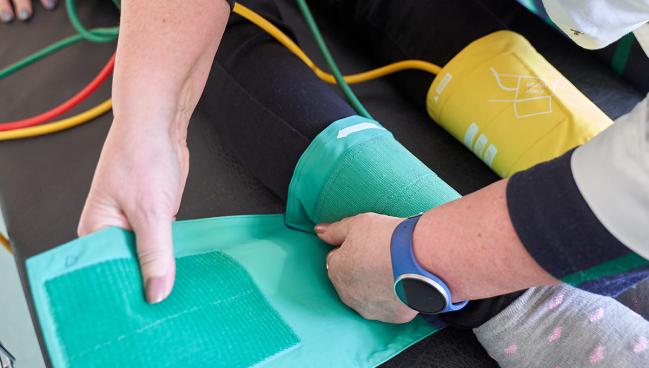JACC Statement Focuses on PAD Disparities, Gaps in Care
The answer to addressing many of these issues is better education and cooperation, says Mary McDermott.

Significant gaps need to be addressed in the prevention, diagnosis, and treatment of individuals with peripheral artery disease (PAD), with special emphasis on improving awareness of what the disease is and who it affects most, according to a new scientific statement commissioned by the Journal of the American College of Cardiology.
The statement is the second one this year focused on inequities in PAD care, the other being a scientific statement from the American Heart Association (AHA) published in June. Both documents also come on the heels of the development, by AHA and other organizations, of a PAD National Action Plan, which includes committees that are addressing six major areas: public awareness, detection and treatment, public health, professional education, research, and advocacy.
The new paper reviews what is known about PAD in the United States, including data showing consistent associations between Black, Hispanic, and Native American race/ethnicity and higher amputation rates compared with white patients, and delves into literature supporting disparities by sex, geographic location, and income.
“We first wanted to summarize what we know and then propose solutions to address all of these different types of disparities,” lead author Mary M. McDermott, MD (Northwestern University Feinberg School of Medicine, Chicago, IL), told TCTMD. “I think a lot of the physicians who treat people with peripheral artery disease, whether they are primary care, cardiology, vascular medicine, vascular surgery . . . I don't think they're aware of the extent and the type of disparities, and patients are also not aware.”
McDermott added that rather than the solution being innovation, the answer to addressing many of these issues is better education and cooperation between physicians, communities, payers, and patients.
Proposed Solutions
McDermott and colleagues note that even the term “peripheral” may imply to some that it is not that important. Although the authors do not propose an alternative name, they say finding nomenclature “that depicts PAD as part of a systemic process that includes an increased risk for stroke, myocardial infarction, amputation, and mobility impairment may be more effective.”
Also important are recent data suggesting that only about 65% of people with PAD are aware of their diagnosis. Lack of PAD awareness, they add, may accentuate disparities by contributing to lower rates of diagnosis, prevention, and optimal treatment. “If we could implement widespread education of both clinicians and patients, I think that is something important that we're not doing well,” McDermott said.
In addition to the PAD National Action Plan, the scientific statement points to the need for awareness campaigns that use culturally appropriate language, and that target areas known to have a high rates of undiagnosed PAD and lower extremity amputations. As TCTMD has previously reported, one tool that has been proposed for helping identify areas like this is a “heat map” that also identifies congressional representatives linked to those communities, the scientific statement notes.
There's a lot of confusion and a lot of lack of awareness across the board. Mary McDermott
Another widespread problem in diagnosing and treating PAD, say McDermott and colleagues, is the high prevalence of atypical symptoms and asymptomatic PAD. They recommend that clinicians ask patients over age 50 about walking ability and leg symptoms while walking, and suggest that public health campaigns should educate on the importance of leg discomfort, weakness, and declines in walking ability as indicators of possible PAD.
“It’s very easy sometimes to miss,” McDermott said. “There's a lot of confusion and a lot of lack of awareness across the board.”
As to who should be screened with ankle-brachial index (ABI) testing, the document notes that individuals with histories of heart disease, stroke, diabetes, or tobacco use should be screened. To TCTMD, McDermott said this is another area where the heat map might be useful for locating individuals and areas where targeted screening should be implemented. Additionally, she said serious consideration should be given to screening all Black patients given their twofold risk of PAD compared with white patients.
Supervised and home-based exercise are other important, but often overlooked measures to help patients with PAD, and the scientific statement encourages more widespread access to these services.
Lastly, the document encourages greater efforts to improve the representation of women and people of lower socioeconomic status in RCTs, and to “maximize participation in randomized clinical trials by people who are Black, Hispanic, Asian, American Indian, and other racial and ethnic minorities in the United States.”
L.A. McKeown is a Senior Medical Journalist for TCTMD, the Section Editor of CV Team Forum, and Senior Medical…
Read Full BioSources
McDermott MM, Ho KJ, Alabi O, et al. Disparities in diagnosis, treatment, and outcomes of peripheral artery disease: JACC scientific statement. J Am Coll Cardiol. 2023;82:2312-2323.
Disclosures
- McDermott reports grant funding from Helixmith and other research support from ArtAssist, Chromadex, ReserveAge, Mars, and Helixmith.





Comments